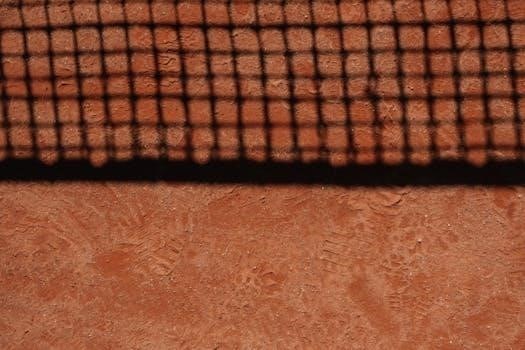Understanding surface area and volume is fundamental in geometry․ These concepts allow us to measure the space occupied by three-dimensional objects and the amount of material needed to cover them․ Worksheets, often in PDF format, help practice these skills․ Regularly working with these worksheets can improve understanding and problem-solving abilities․
Understanding Surface Area
Surface area is the total area of all the surfaces of a three-dimensional object․ Think of it as the amount of wrapping paper needed to cover a gift box․ To calculate surface area, we essentially “unfold” the 3D shape into a 2D net, which shows all the faces․ Then, we find the area of each individual face and add them together․ For instance, with a prism, you’d calculate the areas of the rectangular sides and the two bases, whether they are rectangular or triangular․ The process involves identifying all the shapes that make up the object’s exterior, calculating their individual areas, and summing those areas․ Surface area is measured in square units such as square centimeters, square meters, or square inches․ Many PDF worksheets provide practice problems with varied shapes, and these are often designed for students to practice this concept, by requiring them to calculate each individual surface and then to add them together․ It’s a critical skill in real world applications, such as figuring out how much paint is needed to cover a wall․
Understanding Volume
Volume refers to the amount of space a three-dimensional object occupies․ It’s like figuring out how much water a container can hold․ For prisms, whether rectangular or triangular, the volume is found by multiplying the area of the base by the height of the prism․ This concept applies to a variety of shapes, although the formula for calculating the base area changes based on the shape of the base․ Volume is measured in cubic units, such as cubic centimeters, cubic meters, or cubic inches․ When working with complex shapes, one might need to divide them into simpler geometric figures to calculate the total volume․ PDF worksheets often offer exercises involving various shapes, encouraging a deeper understanding of volume calculations․ Understanding volume has many practical applications, such as determining the capacity of storage containers or calculating the amount of material needed to fill a space․ Regular practice with these worksheets helps to solidify the concept of volume and its calculations․ It is important to remember that the concept of volume is fundamentally different from that of surface area, and both require their own unique methods of calculation․

Worksheet Types and Formats
Surface area and volume worksheets come in various types and formats․ Many are available as downloadable PDF files, offering convenient practice․ These worksheets often cater to specific grade levels and include diverse problems․ They are designed to enhance learning through consistent practice․
PDF Worksheets for Practice
PDF worksheets are a fantastic resource for practicing surface area and volume calculations․ These readily available documents can be easily downloaded and printed, providing students with tangible materials to work on․ The convenience of PDF format allows for repeated practice and helps reinforce concepts․ Many online platforms offer free PDF worksheets tailored to various skill levels, ensuring a suitable challenge for every learner․ These worksheets often include a variety of problems, from basic calculations to more complex word problems involving different shapes such as prisms, cylinders, and pyramids․ The structure of PDF worksheets usually includes clear instructions and ample space for students to show their work․ Additionally, many worksheets provide answer keys, enabling students to check their progress and identify areas where they may need further assistance․ This immediate feedback is invaluable for efficient learning and skill development․ By using PDF worksheets regularly, students can build confidence and master the concepts of surface area and volume effectively․

Grade-Specific Worksheets (5th-8th Grade)
Grade-specific worksheets play a crucial role in scaffolding the learning of surface area and volume, especially for students in 5th through 8th grade․ These worksheets are designed to align with the curriculum standards for each grade level, ensuring students are challenged appropriately․ For instance, 5th-grade worksheets might focus on simple rectangular prisms, while 8th-grade worksheets might include more complex shapes like cylinders and composite figures․ The progressive difficulty in these worksheets helps solidify foundational concepts before moving on to more advanced calculations․ Worksheets tailored for specific grades often take into account the developmental stage of the students․ They use age-appropriate language and problem-solving scenarios to engage students effectively․ Moreover, these worksheets are created to build on prior learning, gradually introducing new concepts while reinforcing previously learned material․ By using worksheets designed for their particular grade level, students can gain a stronger understanding of surface area and volume, and develop confidence in their mathematical abilities․ This carefully planned approach maximizes the effectiveness of practice and learning․

Specific Shapes and Calculations
Focusing on specific shapes like prisms and cylinders is key to mastering surface area and volume․ Calculations for these shapes involve distinct formulas and approaches․ Practice using PDF worksheets ensures a better understanding of these calculations․
Surface Area and Volume of Prisms
Prisms, whether rectangular or triangular, are fundamental three-dimensional shapes in geometry, and understanding their surface area and volume is crucial․ To find the surface area of a prism, visualize unfolding it like a box, which reveals all the individual faces․ The total surface area is the sum of the areas of each of these faces; For example, a rectangular prism has six rectangular faces, whereas a triangular prism has two triangular bases and three rectangular faces․ Calculating these areas accurately requires understanding of basic geometric shapes and their formulas․
Volume calculation for prisms is relatively straightforward․ The volume of any prism, regardless of the shape of its base, is found by multiplying the area of its base by its height․ If ‘B’ represents the area of the base and ‘h’ represents the height of the prism, then the volume (V) is given by V = B * h․ Worksheets in PDF format often provide various problems that help students practice these calculations․ These can include different dimensions, requiring students to determine areas and volumes accurately․ Regular practice with such worksheets can greatly improve understanding and proficiency in this area of mathematics, covering both the theory and the application of the formulas․
Surface Area and Volume of Cylinders
Cylinders are common three-dimensional shapes that present a unique set of calculations for surface area and volume; To understand the surface area of a cylinder, imagine unwrapping its curved surface to form a rectangle and adding the two circular bases․ This makes it clear that the total surface area is made up of a rectangle and two circles․ The area of the rectangle is the product of the cylinder’s height and the circumference of its base, while the circular bases have areas of πr²․ Therefore, the formula for the total surface area of a cylinder is 2πrh + 2πr², where ‘r’ is the radius of the base and ‘h’ is the height of the cylinder․
Calculating the volume of a cylinder is also straightforward․ Similar to prisms, the volume is found by multiplying the area of the base by the height of the cylinder․ Since the base of a cylinder is a circle with the area πr², the formula for the volume of the cylinder is V = πr²h․ PDF worksheets often include a variety of exercises on cylinders, involving different values for radii and heights․ These exercises can help students understand the relationship between the dimensions of a cylinder and its surface area and volume․ Practicing with these worksheets will enhance students’ abilities to apply the relevant formulas and solve related problems effectively, solidifying their understanding of these key geometric concepts․

Advanced Concepts and Applications
Beyond basic calculations, advanced topics include scale factors, surface area, and volume relationships․ Ratios of surface areas and volumes, along with word problems, provide real-world applications․ These concepts enhance problem-solving and analytical skills using PDF worksheets․
Scale Factors, Surface Area, and Volume
Exploring the relationship between scale factors, surface area, and volume is crucial for understanding how changes in dimensions affect geometric properties․ When a three-dimensional shape is scaled, its surface area and volume change by different powers of the scale factor․ Specifically, if the linear dimensions of a solid are multiplied by a scale factor ‘k’, the surface area is multiplied by ‘k2‘, and the volume is multiplied by ‘k3‘․ This principle applies to all similar solids, whether they are prisms, cylinders, or other shapes․ PDF worksheets often include exercises where students are asked to compare similar shapes, determine the scale factor, and find corresponding surface areas and volumes․ These worksheets can also include finding the ratio of these measurements․ Understanding these relationships is essential for solving more complex problems, such as those found in word problem scenarios․ For instance, a question might ask how much the surface area and volume of a box increase if all of its dimensions are doubled․ Using these worksheets regularly will help students grasp these concepts more effectively․ These worksheets are particularly helpful for students in grade 8 and high school․
Ratio of Surface Areas and Volumes
The ratio of surface areas and volumes is a fundamental concept when comparing similar three-dimensional shapes․ When two solids are similar, their linear dimensions are proportional, which directly affects their surface areas and volumes․ If the ratio of corresponding sides (the scale factor) of two similar solids is ‘a⁚b’, then the ratio of their surface areas will be ‘a2⁚b2‘, and the ratio of their volumes will be ‘a3⁚b3‘․ Understanding these relationships is crucial for solving problems involving scaling and geometric proportions․ PDF worksheets often contain problems that require students to calculate these ratios when given various measurements of similar solids․ For example, they might need to determine the ratio of volumes when the ratio of surface areas is provided, or vice versa․ Furthermore, such worksheets also help students grasp the concept that the ratio of surface areas and volumes will never be the same, unless the scale factor is exactly 1․ These worksheets help students practice these concepts and improve their ability to problem solve․ Practicing with these worksheets will strengthen your foundational knowledge․
Word Problems Involving Surface Area and Volume
Word problems involving surface area and volume are essential for applying theoretical knowledge to practical situations․ These problems require students to identify relevant information, determine the appropriate formulas, and perform calculations to find solutions․ PDF worksheets often feature a variety of word problems that challenge students to visualize real-world scenarios and translate them into mathematical equations․ For example, a problem might involve calculating the amount of paint needed to cover a cylindrical tank or determining the volume of sand required to fill a box․ These problems move beyond simple calculations and require critical thinking․ Students learn to distinguish between the need to calculate surface area versus volume, a common point of confusion․ They also learn to interpret the units of measurement within the context of the problem, ensuring that their answers make sense․ Furthermore, these word problems help students understand the practical applications of geometry in daily life․ By working through these worksheets, students develop problem-solving skills and enhance their ability to relate mathematical concepts to real-world situations․ The use of PDF worksheets allows for easy access and repeated practice․